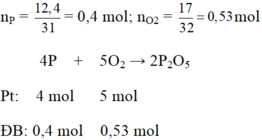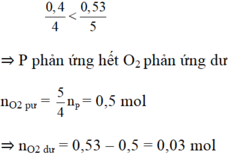Đốt cháy 12,4g P trong bình đựng chứa 17g O2 tạo thành P2O5.
a) Photpho hay Oxi dư?
b) Khối lượng P2O5 thu được sau phản ứng.
Hãy nhập câu hỏi của bạn vào đây, nếu là tài khoản VIP, bạn sẽ được ưu tiên trả lời.

a) $n_P = \dfrac{12,4}{31} = 0,4(mol) ; n_{O_2} = \dfrac{17}{32} = 0,53125(mol)$
$4P + 5O_2 \xrightarrow{t^o} 2P_2O_5$
Ta thấy :
$n_P : 4 < n_{O_2} : 5$ nên $O_2$ dư
$n_{O_2\ pư} = \dfrac{5}{4}n_P = 0,5(mol)$
$\Rightarrow n_{O_2\ dư} = 0,53125 - 0,5 = 0,03125(mol)$
b) Điphotpho pentaoxit được tạo thành
$n_{P_2O_5} = \dfrac{1}{2}n_P = 0,2(mol)$
$m_{P_2O_5} = 0,2.142 = 28,4(gam)$

\(n_P=\dfrac{m_p}{M_P}=\dfrac{12,4}{31}=0,4mol\)
\(n_{O_2}=\dfrac{m_{O_2}}{M_{O_2}}=\dfrac{17}{32}=0,53125mol\)
\(4P+5O_2\underrightarrow{t^o}2P_2O_5\)
4 5 2 ( mol )
0,4 0,53125 ( mol )
ta có: \(\dfrac{0,4}{4}< \dfrac{0,53125}{5}\)
=> Chất dư là \(O_2\)
\(n_{O_2\left(du\right)}=0,53125-0,5=0,03125mol\)
Chất được tạo thành là \(P_2O_5\)
\(m_{P_2O_5}=n_{P_2O_5}.M_{P_2O_5}=\left(\dfrac{0,4.2}{4}\right).142=28,4g\)

Khối lượng khí Oxi đã phản ứng là:
mP2O5 = mP + mO2
28,4 = 12,4 + mO2
mO2 = 28,4 - 12,4
mO2 = 16 g

a)

Xét tỉ lệ số mol đề bài với số mol phương trình của P và O2 ta có:

b) Chất tạo thành: đi photpho pentaoxit P2O5
Theo phương trình 
mP2O5 = n.M = 0,2.(31.2 + 16.5) = 28,4 (g)

Bài 4:
a) \(n_P=\dfrac{12,4}{31}=0,4\left(mol\right)\)
\(n_{O_2}=\dfrac{17}{32}=0,53125\left(mol\right)\)
PTHH: 4P + 5O2 --to--> 2P2O5
Xét tỉ lệ: \(\dfrac{0,4}{4}< \dfrac{0,53125}{5}\) => P hết, O2 dư
PTHH: 4P + 5O2 --to--> 2P2O5
0,4-->0,5--------->0,2
=> \(n_{O_2\left(dư\right)}=0,53125-0,5=0,03125\left(mol\right)\)
b) \(m_{P_2O_5}=0,2.142=28,4\left(g\right)\)

Số mol photpho và khí oxi lần lượt là 12,4:31=0,4 (mol) và 17:32=0,53125 (mol).
A) 4P (0,4 mol) + 5O2 (0,5 mol) \(\underrightarrow{t^o}\) 2P2O5 (0,2 mol).
0,4:4<0,53125:5 nên khí oxi dư và dư 0,53125-0,5=0,03125 (mol).
B) Điphotpho pentaoxit (P2O5) được tạo thành có khối lượng là 0,2.142=28,4 (g).

\(n_P=\dfrac{12,4}{31}=0,4\left(mol\right)\\
pthh:4P+5O_2\underrightarrow{t^o}2P_2O_5\)
0,4 0,2
\(m_{P_2O_5}=142.0,2=28,4g\)
\(n_{O_2}=\dfrac{17}{32}=0,53\left(mol\right)\)
\(pthh:4P+5O_2\underrightarrow{t^o}2P_2O_5\\
LTL:\dfrac{0,4}{4}< \dfrac{0,53}{5}\)
=> O2 dư
\(n_{O_2\left(p\text{ư}\right)}=\dfrac{5}{4}n_P=0,5\left(mol\right)\\
m_{O_2\left(d\right)}=\left(0,53-0,5\right).32=0,96g\)
`4P + 5O_2` $\xrightarrow[]{t^o}$ `2P_2 O_5`
`0,4` `0,5` `0,2` `(mol)`
`n_P = [ 12,4 ] / 31 = 0,4 (mol)`
`a) m_[P_2 O_5] = 0,2 . 142 = 28,4 (g)`
`b) n_[O_2] = 17 / 32 = 0,53125 (mol)`
Ta có: `[ 0,4 ] / 4 < [ 0,53125 ] / 5`
`->O_2` dư
`=> m_[O_2 (dư)] = ( 0,53125 - 0,5 ) . 32 = 1(g)`

\(n_P=\dfrac{m_P}{M_P}=\dfrac{12,4}{31}=0,4mol\)
\(n_{O_2}=\dfrac{m_{O_2}}{M_{O_2}}=\dfrac{17}{32}=0,53125mol\)
\(4P+5O_2\rightarrow\left(t^o\right)2P_2O_5\)
0,4 < 0,53125 ( mol )
0,4 0,5 0,2 ( mol )
\(n_{O_2\left(du\right)}=0,53125-0,5=0,03125mol\)
Chất được tạo thành là P2O5
\(m_{P_2O_5}=n_{P_2O_5}.M_{P_2O_5}=0,2.142=18,4g\)

\(n_P=\dfrac{m}{M}=\dfrac{6,2}{31}=0,2\left(mol\right)\)
\(n_{O_2}=\dfrac{V}{22,4}=\dfrac{7,84}{22,4}=0,35\left(mol\right)\)
PTHH:\(4P+5O_2\rightarrow2P_2O_5\)
tpứ: 0,2 0,35
pứ: 0,2 0,25 0,1
spứ: 0 0,1 0,1
a)chất còn dư là oxi
\(m_{O_2dư}=n.M\)=0,1.32=3,2(g)
b)\(m_{P_2O_5}=n.M\)=0,1.142=14,2(g)

\(n_P=\dfrac{6.2}{31}=0.2\left(mol\right)\)
\(n_{O_2}=\dfrac{7.84}{22.4}=0.35\left(mol\right)\)
\(4P+5O_2\underrightarrow{^{^{t^0}}}2P_2O_5\)
\(4........5\)
\(0.2........0.35\)
\(LTL:\dfrac{0.2}{4}< \dfrac{0.35}{5}\Rightarrow O_2dư\)
\(m_{O_2\left(dư\right)}=\left(0.35-0.25\right)\cdot32=3.2\left(g\right)\)
\(m_{P_2O_5}=0.1\cdot142=14.2\left(g\right)\)
Tham khảo nha!!!
nP = 6,2/31 = 0,2 mol ; nO2 = 7,84/22,4 = 0,35 mol
a, PTHH : 4P + 5O2 (to) -> 2P2O5
0,2 0,35 mol
Ta thấy : 0,2/4 < 0,35/5 -> nO2 dư = 0,35 - 0,05*5 = 0,1 mol
-> mO2 dư = 0,1*32 = 3,2 gam
b, Theo pt : nP2O5 = 1/2*nP = 0,1 mol -> mP2O5 = 0,1*142 = 14,2 gam
4P+5O2-->2P2O5
a) n P=12,4/31=0,4(mol)
n O2=17/32=0,53(mol)
0,4/4<0,53/5
-->O2 dư
b) n P2O5=1/2n P=0,2(mol)
m P2O5=0,2.142=28,4(g)
a) PTHH: 4P + 5O2 -to-> 2P2O5
Ta có: nP=12,4\31=0,4(mol)nO2=17\32(mol)
Theo PTHH và đề bài, ta có:
0,4\4<17\32\5
=> P hết, O2 dư nên tính theo nP.
=> nO2(phảnứng)=5.0,44=0,5(mol)=>nO2(dư)=1732−0,5=1\32(mol)
b) Chất tạo thành sau phản ứng là P2O5 (điphotpho pentaoxit).
Theo PTHH và đề bài, ta có:
nP2O5=2.0,4\4=0,2(mol)
Khối lượng P2O5 tạo thành sau phản ứng:
mP2O5=0,2.142=28,4(g)